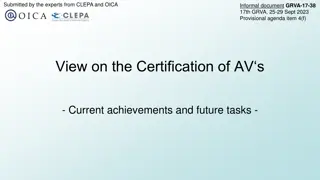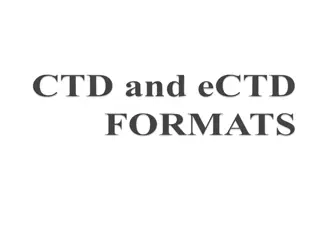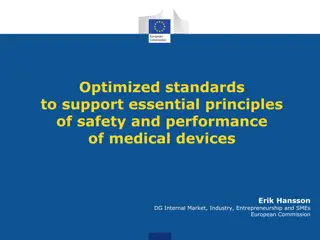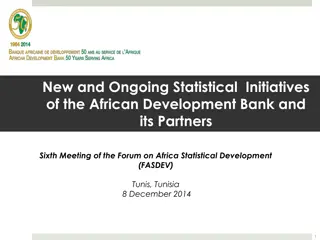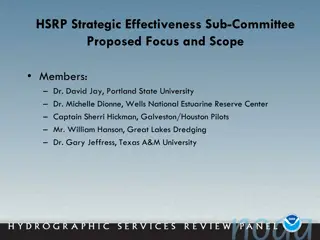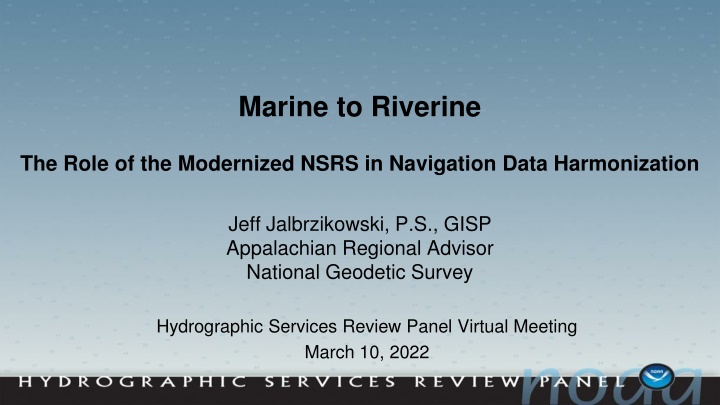
Modernizing NSRS for Navigation Data Harmonization and Vertical Datum Shifts
Explore the transformation of the National Spatial Reference System (NSRS) and upcoming shift from NAVD 88 to NAPGD2022, impacting navigation heights. Learn about the challenges in referencing data to different datums and the potential solutions provided by technology and standards like NOAA VDatum.
Download Presentation

Please find below an Image/Link to download the presentation.
The content on the website is provided AS IS for your information and personal use only. It may not be sold, licensed, or shared on other websites without obtaining consent from the author. If you encounter any issues during the download, it is possible that the publisher has removed the file from their server.
You are allowed to download the files provided on this website for personal or commercial use, subject to the condition that they are used lawfully. All files are the property of their respective owners.
The content on the website is provided AS IS for your information and personal use only. It may not be sold, licensed, or shared on other websites without obtaining consent from the author.
E N D
Presentation Transcript
Marine to Riverine The Role of the Modernized NSRS in Navigation Data Harmonization Jeff Jalbrzikowski, P.S., GISP Appalachian Regional Advisor National Geodetic Survey Hydrographic Services Review Panel Virtual Meeting March 10, 2022
NOAAs National Geodetic Survey National Spatial Reference System (NSRS) Current Vertical Datum = NAVD 88 Forthcoming = NAPGD2022 Impact? heights are going to change Not a simple add half a foot Varies geographically
Note the color shading stops at the shoreline. So too does the geodetic vertical datum (NAVD 88). Colors approximate the shift from NAVD 88 to NAPGD2022 (in centimeters) Ranges from -0.6 to -3.9 feet Inland Waterways System overlaid with Vertical Datum Shift
Color shaded area illustrates coverage of NAPGD2022 geoid. Part of its value lies in its broader applicability (e.g. Pacific Islands)
Whats the issue at hand? Published data are referenced to various datums NOAA ENC MLLW USACE IENC MLLW, Project Pool, Normal Pool USCG Light List MLW; above normal pool, navigation pool, upper navigation pool, minimum pool, flat pool, pool stage, zero gauge, LWD, high water, low water above 1937 high water above elevation 157.0 feet MSL above 2% flowline elevation 576.5 feet msl above zero on W.B. gauge at Caruthersville
At first glance Easy answer! Everyone use the ellipsoid as reference surface Everyone convert to the same vertical datum Not easy to implement! Sparse data coverage conversion from ellipsoid suffers Inconsistencies due to differing operational needs Subsidence in Gulf, Chesapeake, and elsewhere
Possibility Yes, the technology and standards exist NOAA VDatum Move bathymetric data to the same datum IHO S-100 Standard S-102 Bathymetric Surface (soundings) S-104 Water Level Surface (gage data)
Plausibility? Not plausible with existing resources VDatum is a big part of the answer But has a very small team Joint product of NGS, OCS, CO-OPS the small team is stretched among those 3 offices Sparse data coverage in some areas Subsidence is reality (slow but steady)
Closing Thoughts Opening talk ECDIS/user systems see liabilities Datum harmonization before data dissemination ...we are calculating bridge heights the same way the Egyptians did. shallow draft wooden skiffs vs. 50ft draft Post-Panamax ships Government hydro/bathy data need a common reference surface Already have one ellipsoid heights via GNSS
Closing Thoughts Need to accurately convert from Ellipsoid Higher density data leads to higher accuracy datum transformations Common Water Level Huge investments in the physical infrastructure (MRSC $160m) What about investments in the invisible infrastructure ? Support for VDatum and related models/products GNSS on Tidal BMs, Improved TSS modeling, Monitoring of VLM Altogether increase accuracy


